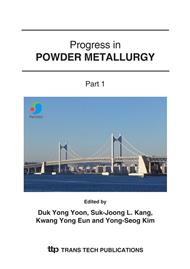[1]
W.B. James and R.C. O'Brien, High Performance Ferrous P/M Materials: The Effect of Alloying Method on Dynamic Properties, Progress in Powder Metallurgy, compiled by E.A. Carlson and G. Gaines, Metal Powder Industries Federation, Princeton, NJ, vol. 42, 1986, pp.353-372.
Google Scholar
[2]
U. Engstrom, A Newly Developed Sintered High Strength Material, Horizons of Powder Metallurgy, Edited by W.A. Kaysser and W.J. Huppmann, Proc. 1986 World PM Con., EPMA, Dusseldorf, 1986, part II, pp.1039-1048.
Google Scholar
[3]
J.J. Fulmer and R.J. Causton, Tensile, Impact and Fatigue Performance of a New Water Atomized Low-Alloy Powder-Ancorsteel 85HP, Advances in Powder Metallurgy and Particulate Materials, compiled by E.R. Andreotti and P.J. McGeehan, Metal Powder Industries Federation, Princeton, NJ, vol. 2, 1990, pp.459-486.
DOI: 10.1080/10426919208947447
Google Scholar
[4]
R.J. Causton and W.B. James, Performance Characteristics of a New Sinter-Hardening Low Alloy Steel, compiled by L.F. Pease III and R.J. Sansoucy, Advances in Powder Metallurgy and Particulate Materials, Metal Powder Industries Federation, Princeton, NJ, vol. 5, 1991, pp.91-104.
DOI: 10.1080/10426919308934877
Google Scholar
[5]
W.B. James, Effect of Alloying Methods on Thermal Processing and Properties of Ferrous Materials, Industrial Heating, vol. 59, no. 6, 1992, pp.34-39.
Google Scholar
[6]
U. Engstrom, C. Lindberg and J. Tengzelius, Powders and Processes for High Performance PM Steels, Powder Metallurgy, vol. 35, no. 1, 1992, pp.67-72.
DOI: 10.1179/pom.1992.35.1.67
Google Scholar
[7]
C. Lindberg, Sintered High Strength Materials, Advances in Powder Metallurgy and Particulate Materials, compiled by J.M. Capus and R.M. German, Metal Powder Industries Federation, Princeton, NJ, vol. 5, 1992, pp.107-114.
Google Scholar
[8]
W.B. James, Recent Developments in Ferrous Powder Metallurgy Alloys, Int. J. Powder Metallurgy, vol. 30, no. 2, 1994, pp.157-162.
DOI: 10.1016/0026-0657(94)90734-x
Google Scholar
[9]
W.B. James, What is Sinter-Hardening?", PM2TEC, 98 International Conference on Powder Metallurgy and Particulate Materials, May 31- June 4, 1998, Las Vegas, Nevada, Presented at Special Interest Session but not published.
Google Scholar
[10]
S. Sarıtaş, R. Causton, W. B. James and A. Lawley, Effect of Mıcrostructural Inhomogeneıtıes on the Mechanıcal Propertıes of Hybrıd PMSteels, Advances in Powder Metallurgy and Particulate Materials, compiled by W.B. Eisen and S. Kassem, Metal Powder Industries Federation, Princeton, NJ, 2001, part 10, pp.10-51.
Google Scholar
[11]
S. Sarıtaş, R. Causton, W.B. James and A. Lawley, Effect of Microstuctural Inhomogeneities on the Fatigue Crack Growth Response of a Prealloyed and two Hybrid Steels, Advances in Powder Metallurgy and Particulate Materials, compiled by V. Arnhold, C.L. Chu, W.F. Jandeska, Jr. and H.I. Sanderow, Metal Powder Industries Federation, Princeton, NJ, 2002, part 5, p.136.
Google Scholar
[12]
MPIF Standard 35, Materials Standards for PM Structural Parts, Metal Powder Industries Federation, Princeton, NJ, (2000).
Google Scholar
[13]
MPIF Standard 42, Determination of Density of Compacted or Sintered Metal Powder Products, Standard Test Methods for Metal Powders and Powder Metallurgy Products, Metal Powder Industries Federation, Princeton, NJ, (2000).
DOI: 10.1016/s0026-0657(98)90523-9
Google Scholar
[14]
E. Fetullayev, C. Karatas and F. Kafkas, Investigation of Residual Stresses at the Root of a Carburized Gear Produced from AISI 5115 Steel, Journal of Gazi University Faculty of Engineering and Architecture, vol. 16, no. 1, 2001, pp.9-18.
Google Scholar


